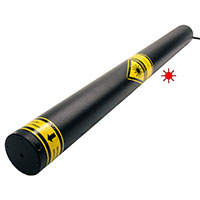HeNe Laser Heads
Results:
24
Manufacturer
Series
Power (Watts)
Wavelength
Polarization
Results remaining:24
HeNe Laser Heads
HeNe or Helium-Neon Laser Heads are laser devices that utilize a gas medium for generating optical gain. The gas mixture used in these laser heads consists of a precise ratio of helium and neon, with the optimal ratio being 10 parts helium to 1 part neon.
In operation, HeNe lasers use an electrical discharge to excite the gas mixture. This discharge creates a plasma within the laser cavity, which causes the helium and neon atoms to become excited. As the excited atoms return to their ground state, they release energy in the form of photons at a specific wavelength within the visible spectrum.
Helium serves as a buffer gas in the laser cavity, helping to stabilize the discharge and improve the overall efficiency of the laser. Neon, on the other hand, provides the necessary energy levels for the emission of coherent light.
The combination of helium and neon in the gas mixture creates an environment in which the excited atoms stimulate each other to emit light in a coherent and monochromatic manner. This coherent light is then amplified as it bounces back and forth between two mirrors within the laser cavity. One of the mirrors is partially reflective, allowing some of the light to escape and form the laser beam.
One of the notable features of HeNe lasers is their ability to emit laser light at a specific wavelength of around 632.8 nanometers, which appears as a red-orange color. This makes HeNe lasers useful in a variety of applications such as scientific research, holography, barcode scanning, and educational demonstrations.
In summary, HeNe or Helium-Neon Laser Heads use a gas mixture of helium and neon, excited by an electrical discharge, to generate coherent and monochromatic laser light at a specific wavelength. The carefully balanced gas mixture enables efficient and stable laser operation, making HeNe lasers valuable in various fields.



